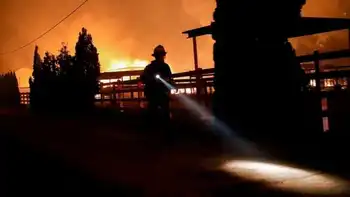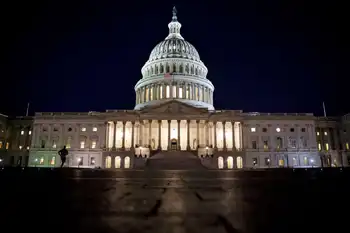Industry defends reactors' security: Nuclear firms tout post-9/11 safeguards
TOLEDO, OHIO - From simulated-attack exercises to physical barriers, there's no question that security at America's 103 nuclear plants has been enhanced since the terrorist attacks of Sept. 11, 2001.
The question, as haunting images from New York, Washington, and Pennsylvania are replayed in the nation's psyche today: Has it been enough?
Spokesmen for FirstEnergy Corp.'s Davis-Besse nuclear plant in Ottawa County and Detroit Edison Co.'s Fermi II nuclear plant in Monroe County said they are limited by what they can divulge about security upgrades, many of which were required by the Nuclear Regulatory Commission or urged by their industry's chief trade group, the Nuclear Energy Institute.
The institute claimed more than $1.2 billion has been invested in nuclear security nationally during the last five years, including a 60 percent increase in paramilitary security forces.
Other improvements include more concrete barriers, electronic surveillance, guard stations, and background checks, according to FirstEnergy's Richard Wilkins and Detroit Edison's John Austerberry.
Both said their plants have worked more closely with local, state, and federal agencies while offering few tours. The Ottawa County sheriff now has a satellite office on Davis-Besse's property, Mr. Wilkins said.
The Ohio Highway Patrol and Michigan State Police are more involved. So is the FBI. The Department of Homeland Security, which was created in response to the attacks, is a new player -- but a major one. The Coast Guard keeps boaters from getting too close via Lake Erie, while the Federal Aviation Administration restricts aircrafts from flying over the plants.
But the National Whistleblower Center in Washington showed less than a month after the attacks how it was possible to fly under the NRC's radar.
On Oct. 3, 2001, while the NRC was focused on removing sensitive material from its electronic Web site, the group sent an intern to the agency's public document room in the Washington suburb of Rockville, Md.
The intern came back with a copy of a 119-page report, written in 1982 by the U.S. Department of Energy's Argonne National Laboratory in Illinois, that laid out the extent to which buildings housing nuclear reactors could be damaged if struck by a jetliner. That report and others have long since been removed from the public domain.
NRC Chairman Dale Klein, who in July became the third person at the agency's helm since the terrorist attacks, said in an Aug. 28 letter he is "confident that these plants are very secure."
The letter, to Homeland Security Secretary Michael Chertoff, said the NRC has increased its budget for security by tenfold since Sept. 11, 2001. It said the agency uses "highly trained adversary forces" for its exercises, which are designed to simulate real attacks.
"The defenses of nuclear plants are being tested through the force-on-force program nearly three times as often as before and in a much more realistic fashion; these defenses are robust," Mr. Klein wrote.
The letter said the NRC is now spending 8,000 hours a year on security inspections, five times the amount of time it devoted to that before the attacks.
U.S. Sen. Charles Schumer (D., N.Y.), a critic of the Bush Administration's efforts to bolster national security, gave the nuclear industry his highest grade in a report analyzing a dozen of the country's perceived vulnerabilities. The average score for the administration was a C-, but the senator gave the nuclear industry a B+.
Yet questions remain.
The Union of Concerned Scientists, a nuclear watchdog group, last week detailed alleged security lapses at the South Texas Project complex near Houston, based on information it claimed to have obtained from whistleblowers. The group said Wackenhut, a private security firm that has come under fire, allowed vehicles to enter areas unsearched, had surveillance cameras that didn't work, and allowed members of the cleaning staff to have access to firearms.
U.S. Rep. Ed Markey (D., Mass.), a senior member of the House Homeland Security Committee, said the Bush Administration is compromising safety by allowing Wackenhut and other private firms to provide security at nuclear plants.
Wackenhut provides security to 30 facilities. Davis-Besse and Fermi aren't among them.
Meanwhile, the debate rages over whether nuclear plants could survive a direct hit from a jetliner.
An industry-sponsored report in 2002, which took months and cost $1 million, claimed reactor buildings are robust enough. But it assumed the fastest speed for a low-flying Boeing 767-400 aircraft weighing 450,000 pounds would be 350 mph.
Greenpeace, citing the Argonne report, last week claimed "the government and the nuclear industry have continued to traffic in half-truths about the vulnerability of nuclear power plants."
The NRC has scheduled a roundtable discussion at its headquarters Thursday to discuss nationwide security enhancements. That event is open to the public. Unlike some NRC meetings, it won't be broadcast on the agency's Web site.
Related News

Alberta set to retire coal power by 2023, ahead of 2030 provincial deadline
CALGARY - Alberta is set to meet its goal to eliminate coal-fired electricity production years earlier than its 2030 target, thanks to recently announced utility conversion projects.
Capital Power Corp.’s plan to spend nearly $1 billion to switch two coal-fired power units west of Edmonton to natural gas, and stop using coal entirely by 2023, was welcomed by both the province and the Pembina Institute environmental think-tank.
In 2014, 55 per cent of Alberta’s electricity was produced from 18 coal-fired generators. The Alberta government announced in 2015 it would eliminate emissions from coal power generation by 2030.
Dale Nally, associate minister of Natural…




